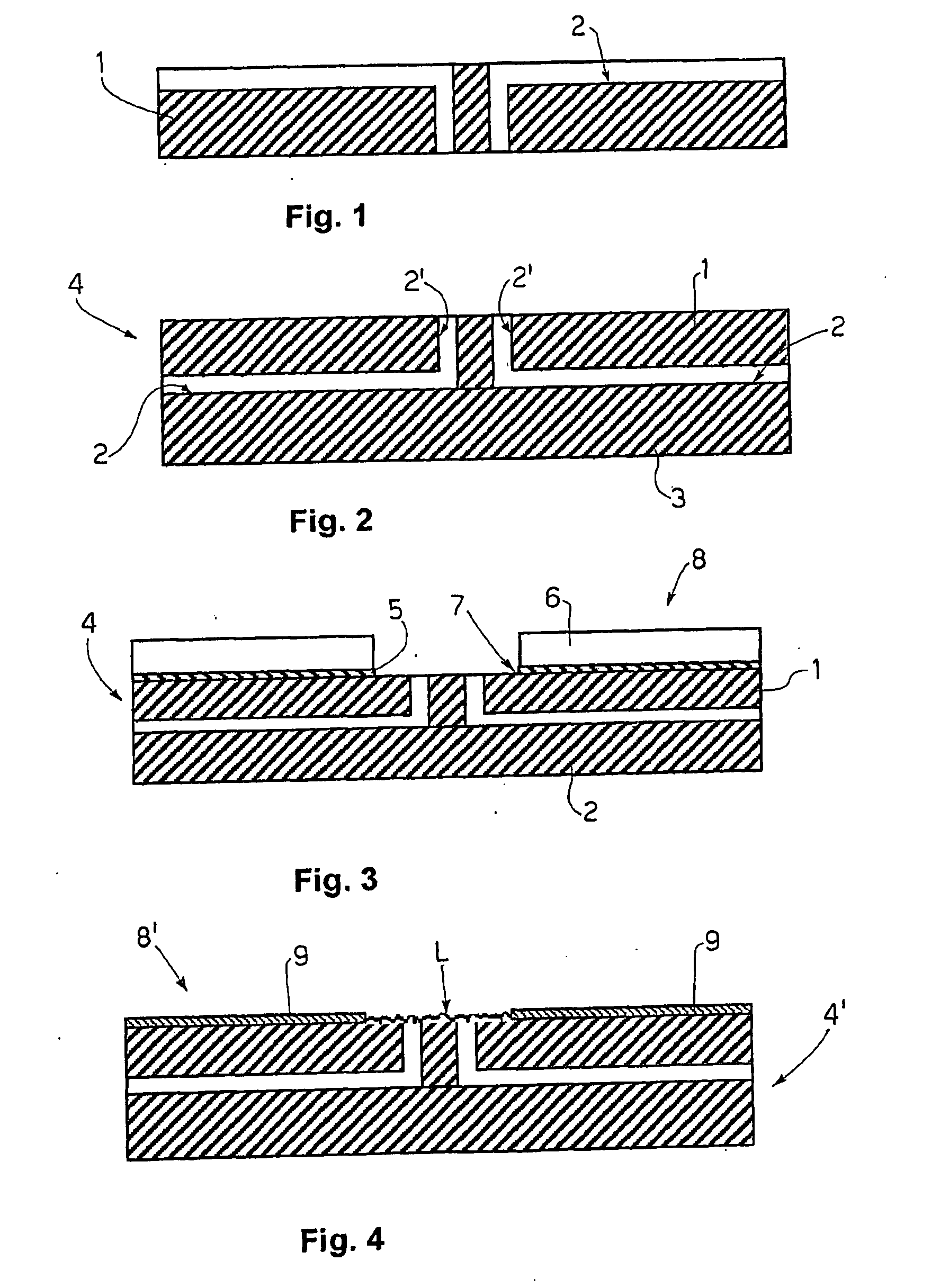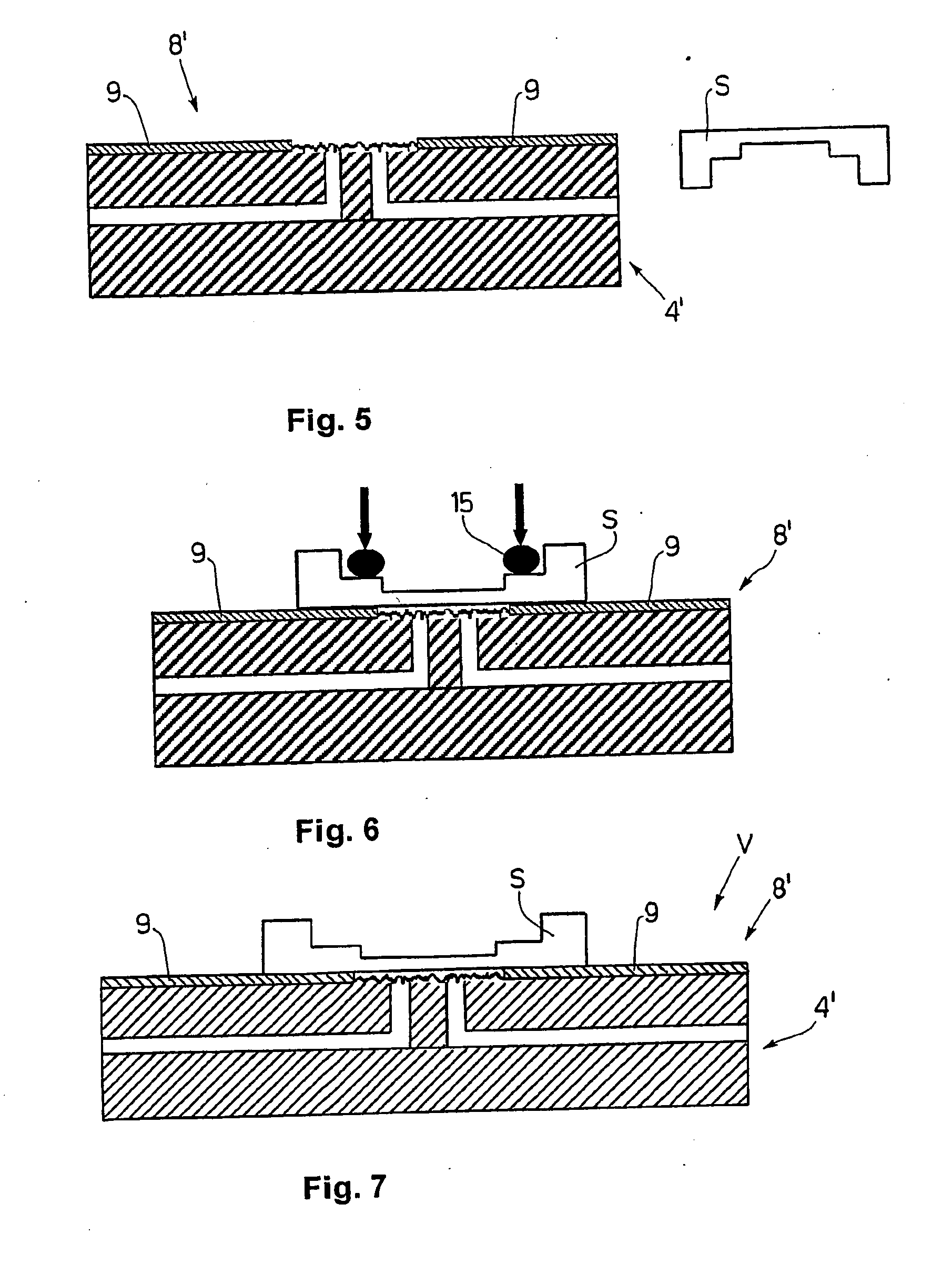Method for Bonding a Layer of Silicone to a Substrate of Methacrylate Polymer
a technology of methacrylate polymer and silicone, which is applied in the direction of decorative arts, paper/cardboard containers, containers, etc., can solve the problems of inability to guarantee satisfactory process, inability to connect the parts in question by irreversible chemical bond formation, and low efficiency of obtained results, so as to achieve easy and inexpensive production
- Summary
- Abstract
- Description
- Claims
- Application Information
AI Technical Summary
Benefits of technology
Problems solved by technology
Method used
Image
Examples
example 1
[0076]This example describes the production of a valve element V (FIG. 7).
[0077]An element 1 of PMMA (polymethylmethacrylate) (thickness 1 mm, width 70 mm, height 70 mm) was milled to obtain channels 2 (diameter approximately 200 μm) (FIG. 2) and then superimposed on and glued to a further element 3 of PMMA (thickness 1 mm, width 70 mm, height 70 mm) to obtain a substrate 4. The gluing was achieved by following the method described in Lab Chip, 2006, 6, 66-73.
[0078]A silicone mask 5 (thickness 1.5 mm) and a steel mask 6 (thickness 2 mm) were superimposed on the substrate 4 in PMMA in order to leave a circle 7 (diameter 4 mm) unprotected and obtain a composite 8 (FIGS. 3 and 9). The composite 8 was placed inside a plasma reactor (Gambetti Plasma, Modello Tucano) modified so that one of the two electrodes were the composite 8 (in particular the steel mask 6). The composite 8 was treated (as shown in FIG. 10) using the parameters given in table 1.
example 2
[0087]This example describes the preparation of 3-(trihydroxysilylpropyl)methacrylate.
[0088]3-(trimethoxysilylpropyl)methacrylate (TMSPM-Fluka Italia) was hydrolysed with distilled water (molar ratio 1:1) leaving it under agitation inside a container positioned on a magnetic plate. The hydrolysis reaction was performed at ambient temperature for two hours and during said hydrolysis the groups —OCH3 are substituted by hydroxyl groups according to the reaction:
RSi(OCH3)3+3H2O→RSi(OH)3+3CH3OH(fast)
RSi(OH)3→R(Si)2(OH)4OR→R(Si)3(OH)5(OR)2(slow)
example 3
[0089]This example describes the operation of a valve (FIGS. 18 and 19).
[0090]The valve comprises a pneumatic actuator (known per se and not illustrated) positioned on the opposite side of the membrane S with respect to the apertures 2′. In use, when the actuator creates a vacuum on the membrane S, the membrane S moves away from the substrate 8′ and connects the channels 2 (FIG. 18); when the actuator compresses the membrane S, the membrane S moves near to the substrate 8′ and closes the apertures 2′ (FIG. 19).
PUM
| Property | Measurement | Unit |
|---|---|---|
| angle of contact | aaaaa | aaaaa |
| angles of contact | aaaaa | aaaaa |
| angles of contact | aaaaa | aaaaa |
Abstract
Description
Claims
Application Information
 Login to View More
Login to View More - R&D
- Intellectual Property
- Life Sciences
- Materials
- Tech Scout
- Unparalleled Data Quality
- Higher Quality Content
- 60% Fewer Hallucinations
Browse by: Latest US Patents, China's latest patents, Technical Efficacy Thesaurus, Application Domain, Technology Topic, Popular Technical Reports.
© 2025 PatSnap. All rights reserved.Legal|Privacy policy|Modern Slavery Act Transparency Statement|Sitemap|About US| Contact US: help@patsnap.com



